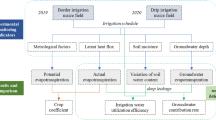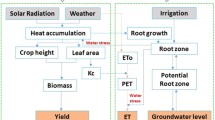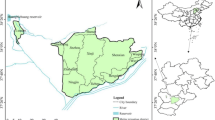Abstract
Agricultural water saving measures play an important role to manage water shortages and agricultural production in arid and semiarid areas. In areas with shallow groundwater, capillary upflow from the groundwater is important for crops to receive adequate water under limited irrigation. To understand the effect of limited irrigation and groundwater on crop water use, a calibrated AquaCrop model with 2 years of field experimental data was used to simulate the increase in groundwater capillary in different depths of groundwater and amounts of irrigation amount. The results showed that the following: (1) Plant transpiration and actual evapotranspiration reached their maximum at a groundwater depth of 1.5 m and decreased as the levels of groundwater decreased. Plant transpiration and actual evapotranspiration remained almost unchanged when the groundwater depth was > 2.5 m. (2) The capillary rise gradually decreased as the groundwater depth increased. When the groundwater depth was at 1 m, the capillary rise could reach 224.3 mm, and the capillary rise in seedling stage accounted for 61.9% of the whole growth period. (3) When the groundwater depth varied from 1.5 to 2.5 m, both the water productivity and irrigation water productivity of maize were maintained at a high level. Since the adjustment of maize yield should not be lower than the local average level, the appropriate irrigation amount should be 279 mm, and irrigation should be conducted during the key growth periods of maize (jointing, tasseling and filling stages). These results should be useful to improve irrigation management considering the groundwater depth distribution for the sustainable development of the semiarid and arid regions and alleviate the shortage of water resources.











Similar content being viewed by others
References
Abedinpour M, Sarangi A, Rajput TBS, Singh M, Pathak H, Ahmad T (2012) Performance evaluation of AquaCrop model for maize crop in a semi-arid environment. Agric Water Manag 110:55–66. https://doi.org/10.1016/j.agwat.2012.04.001
Allen RG, Pereira LS, Raes D et al (1998) Crop evapotranspiration Guidelines for computing crop water requirements[C]//FAO Irrigation and Drainage paper 56[J]. Food and Agriculture Organization of the United Nations, Rome, pp 19–24
Amer R, Ripperdan R, Wang T, Encarnación J (2012) Groundwater quality and management in arid and semi-arid regions: case study, Central Eastern Desert of Egypt. J Afr Earth Sci 69:13–25
Ayars JE, Christen EW, Soppe RW, Meyer WS (2006) The resource potential of in-situ shallow ground water use in irrigated agriculture: a review. Irrig Sci 24(3):147–160. https://doi.org/10.1007/s00271-005-0003-y
Comas LH, Trout TJ, DeJonge KC, Zhang H, Gleason SM (2019) Water productivity under strategic growth stage-based deficit irrigation in maize. Agric Water Manag 212:433–440. https://doi.org/10.1016/j.agwat.2018.07.015
Domínguez A, de Juan JA, Tarjuelo JM, Martínez RS, Martínez-Romero A (2012) Determination of optimal regulated deficit irrigation strategies for maize in a semi-arid environment. Agric Water Manag 110:67–77. https://doi.org/10.1016/j.agwat.2012.04.002
Gao XY, Huo ZL, Qu ZY, Xu X, Huang GH, Steenhuis TS (2017) Modeling contribution of shallow groundwater to evapotranspiration and yield of maize in an arid area. Sci Rep 7:43122. https://doi.org/10.1038/srep43122
Gao XY (2017) Modeling agricultural water productivity in shallow groundwater area. China Agricultural University (in Chinese with English abstract)
Gu BJ, Ju XT, Chang J, Ge Y, Vitousek PM (2015) Integrated reactive nitrogen budgets and future trends in China. Proc Natl Acad Sci USA 112(28):8792–8797. https://doi.org/10.1073/pnas.1510211112
Hao YY, Xu X, Huang QZ, Huang GH (2014) Modeling soil water-salt dynamics and maize yield responses to groundwater depths and irrigations. Trans Chin Soc Agric Eng 30(20):128–136 (in Chinese with English abstract)
Hsiao TC, Heng L, Steduto P, Rojas-Lara B, Raes D, Fereres E (2009) AquaCrop-The FAO crop model to simulate yield response to water: III. Parameterization and testing for maize. Agron J 101(3):448–459. https://doi.org/10.2134/agronj2008.0218s
Huo ZL, Feng SY, Dai XQ, Zheng YY, Wang YH (2012a) Simulation of hydrology following various volumes of irrigation to soil with different depths to the water table. Soil Use Manage 28(2):229–239. https://doi.org/10.1111/j.1475-2743.2012.00393.x
Huo ZL, Feng SY, Huang GH, Zheng YY, Wang YH, Guo P (2012b) Effect of groundwater level depth and irrigation amount on water fluxes at the groundwater table and water use of wheat. Irrig Drain 61(3):348–356. https://doi.org/10.1002/ird.685
Khan S, Hanjra MA, Mu J (2008) Water management and crop production for food security in China: a review. Agric Water Manag 96(3):349–360. https://doi.org/10.1016/j.agwat.2008.09.022
Li X (2003) Pressure of water shortage on agriculture in arid region of China. Chin Geogr Sc 13(2):124–129. https://doi.org/10.1007/s11769-003-0005-8
Li CH, Yang ZF, Wang X (2004) Trends of annual natural runoff in the Yellow River Basin. Water Int 29(4):447–454. https://doi.org/10.1080/02508060408691807
Li FW, Yu D, Zhao Y (2019) Irrigation scheduling optimization for cotton based on the AquaCrop model. Water Resour Manag 33(1):39–55. https://doi.org/10.1007/s11269-018-2087-1
Liu T, Luo Y (2011) Effects of shallow water tables on the water use and yield of winter wheat (Triticum aestivum L.) under rain-fed condition. Aust J Crop Sci 5(13):1692–1697
Liu LG, Cui YL, Feng YH (2010) Water management strategies of Yellow River Irrigation District based on SWAP and MODFLOW models. Trans Chin Soc Agric Eng 26(04):9–17 (in Chinese with English abstract)
Luo Y, Sophocleous M (2010) Seasonal groundwater contribution to crop-water use assessed with lysimeter observations and model simulations. J Hydro 389(3):325–335. https://doi.org/10.1016/j.jhydrol.2010.06.011
Mandal S, Vema VK, Kurian C, Sudheer KP (2020) Improving the crop productivity in rainfed areaswith water harvesting structures and deficit irrigation strategies. J Hydro 586:124818. https://doi.org/10.1016/j.jhydrol.2020.124818
Meng QF, Yue SC, Hou P, Cui ZL, Chen XP (2016) Improving yield and nitrogen use efficiency simultaneously for maize and wheat in China: a review. Pedosphere 26(2):137–147. https://doi.org/10.1016/S1002-0160(15)60030-3
Patanè C, Tringali S, Sortino O (2011) Effects of deficit irrigation on biomass, yield, water productivity and fruit quality of processing tomato under semi-arid Mediterranean climate conditions. Sci Hortic 129(4):590–596. https://doi.org/10.1016/j.scienta.2011.04.030
Pereira LS, Gonçalves JM, Dong B, Mao Z, Fang SX (2007) Assessing basin irrigation and scheduling strategies for saving irrigation water and controlling salinity in the upper Yellow River Basin, China. Agric Water Manag 93(3):109–122. https://doi.org/10.1016/j.agwat.2007.07.004
Prathapar SA, Qureshi AS (1999) Modelling the effects of deficit irrigation on soil salinity, depth to water table and transpiration in semi-arid zones with monsoonal rains. Int J Water Resour D 15(1–2):141–159. https://doi.org/10.1080/07900629948989
Raes D, Geerts S, Kipkorir E, Wellens K, Sahli A (2006) Simulation of yield decline as a result of water stress with a robust soil water balance model. Agric Water Manag 81(3):335–357. https://doi.org/10.1016/j.agwat.2005.04.006
Ranjbar A, Rahimikhoob A, Ebrahimian H, Varavipour M (2019) Assessment of the AquaCrop model for simulating maize response to different nitrogen stresses under semi-arid climate. Commun Soil Sci Plan 50(22):2899–2912. https://doi.org/10.1080/00103624.2019.1689254
Sales CRG, Ribeiro RV, Silveira JAG, Machado EC, Martins MO, Lagôa AMMA (2013) Superoxide dismutase and ascorbate peroxidase improve the recovery of photosynthesis in sugarcane plants subjected to water deficit and low substrate temperature. Plant Physiol Bioch 73:326–336. https://doi.org/10.1016/j.plaphy.2013.10.012
Silveira LK, Pavão GC, dos Dias CTS, Quaggio JA, de Pires RCM (2020) Deficit irrigation effect on fruit yield, quality and water use efficiency: a long-term study on Pêra-IAC sweet orange. Agric Water Manag 231:106019. https://doi.org/10.1016/j.agwat.2020.106019
Smilovic M, Gleeson T, Adamowski J (2016) Crop kites: determining crop-water production functions using crop coefficients and sensitivity indices. Adv Water Resour 97:193–204. https://doi.org/10.1016/j.advwatres.2016.09.010
Steduto P, Albrizio R (2005) Resource-use efficiency of field-grown sunflower, sorghum, wheat and chic-kpea. II. Water use efficiency and comparison with radiation use efficiency. Agr Meteorol 130:269–281. https://doi.org/10.1016/j.agrformet.2005.04.003
Sun HY, Liu CM, Zhang XY, Shen YJ, Zhang YQ (2006) Effects of irrigation on water balance, yield and WUE of winter wheat in the North China Plain. Agric Water Manag 85(1–2):211–218. https://doi.org/10.1016/j.agwat.2006.04.008
Tang LS, Li Y, Zhang JH (2010) Partial rootzone irrigation increases water use efficiency, maintains yieldand enhances economic profit of cotton in arid area. Agric Water Manag 97(10):1527–1533. https://doi.org/10.1016/j.agwat.2010.05.006
Tian YN, Shao DG, Li SM, Wang B (2019) Response of rice water requirement to groundwater depths and irrigations simulation in cold region of northeast China. J Irrig Drain 38(12):68–77 (in Chinese with English abstract)
Torres EA, Calera A (2010) Bare soil evaporation under high evaporation demand: a proposed modification to the FAO-56 model. Hydrolog Sci J 55(3):303–315. https://doi.org/10.1080/02626661003683249
Van Gaelen H, Tsegay A, Delbecque N, Shrestha N, Garcia M, Fajardo H, Miranda R, Vanuytrecht E, Abrha B, Diels J, Raes D (2015) A semi-quantitative approach for modelling crop response to soil fertility: evaluation of the AquaCrop procedure. J Agric Sci 153(7):1218–1233. https://doi.org/10.1017/S002185961400087
Xing YY (2011) Effects of water deficit and nitrogen nutrition on growth, water and nitrogen transport and utilization of maize at different growth stages. Northwest A&F University (in Chinese with English abstract)
Xu X, Huang GH, Sun C, Pereira LS, Ramos TB, Huang QZ, Hao YY (2013) Assessing the effects of water table depth on water use, soil salinity and wheat yield: searching for a target depth for irrigated areas in the upper Yellow River basin. Agric Water Manag 125:46–60. https://doi.org/10.1016/j.agwat.2013.04.004
Xue JY (2018) Modeling agricultural water productivity at multi-scales based on water and salt processes in arid area with shallow groundwater. China Agricultural University (in Chinese with English abstract)
Xue JY, Ren L (2017) Assessing water productivity in the Hetao Irrigation District in Inner Mongolia by an agro-hydrological model. Irrig Sci 35(4):357–382. https://doi.org/10.1007/s00271-017-0542-z
Xue Z, Akae T, Morita H (2013) Estimation of evaporation from arid-irrigated region using MODIS satellite imagery. Paddy Water Environ 11(1–4):185–192. https://doi.org/10.1007/s10333-011-0303-1
Yang J (1999) A review on water exchange through interface between groundwater, soil moisture or atmospheric water. Adv Water Sci 2:84–90 (in Chinese with English abstract)
Yang T, Xu CY, Shao QX, Chen X, Lu GH, Hao ZC (2010) Temporal and spatial patterns of low-flow changes in the Yellow River in the last half century. Stoch Environ Res Risk A 24(2):297–309. https://doi.org/10.1007/s00477-009-0318-y
Yu RH, Liu TX, Xu YP, Zhu C, Zhang Q, Qu ZY, Liu XM, Li CY (2010) Analysis of salinization dynamics by remote sensing in Hetao Irrigation District of North China. Agric Water Manag 97(12):1952–1960. https://doi.org/10.1016/j.agwat.2010.03.009
Zhai BY, Fu Q, Li TX, Liu D, Ji Y, Li M, Cui S (2019) Rice irrigation schedule optimization based on the AquaCrop model: study of the Longtouqiao Irrigation District. Water 11(9):1799. https://doi.org/10.3390/w11091799
Zhang HM, Xiong YW, Huang GH, Xu X, Huang QZ (2017) Effects of water stress on processing tomatoes yield, quality and water use efficiency with plastic mulched drip irrigation in sandy soil of the Hetao Irrigation District. Agric Water Manag 179:205–214
Zhang XX, Guo P, Zhang F, Liu X, Yue Q, Wang YZ (2021) Optimal irrigation water allocation in Hetao Irrigation District considering decision makers’ preference under uncertainties. Agric Water Manag 246:106670. https://doi.org/10.1016/j.agwat.2020.106670
Zhao N, Liu Y, Cai JB, Paredes P, Rosa RD, Pereira LS (2013) Dual crop coefficient modelling applied to the winter wheat-summer maize crop sequence in North China Plain: Basal crop coefficients and soil evaporation component. Agric Water Manag 117:93–105. https://doi.org/10.1016/j.agwat.2012.11.008
Zheng J, Fan JL, Zhang FC, Zhuang QL (2020) Evapotranspiration partitioning and water productivity of rainfed maize under contrasting mulching conditions in Northwest China. Agric Water Manag 243:106473. https://doi.org/10.1016/j.agwat.2020.106473
Zhou LF, Feng H (2020) Plastic film mulching stimulates brace root emergence and soil nutrient absorption of maize in an arid environment. J Sci Food Agric 100:540–550. https://doi.org/10.1002/jsfa.10036
Zhou LF, Feng H, Zhao Y, Qi ZJ, Zhang TB, He JQ, Dyck M (2019) Drip irrigation lateral spacing and mulching affects the wetting pattern, shoot-root regulation, and yield of maize in a sand-layered soil. Agric Water Manag 217:292–302. https://doi.org/10.1016/j.agwat.2017.01.008
Acknowledgements
This research was jointly supported by the National Science Foundation of China (Grant numbers: 51839006, 52069021).
Author information
Authors and Affiliations
Corresponding author
Ethics declarations
Conflict of interest
The authors declare that they have no known competing financial interests or personal relationships that could have appeared to influence the work reported in this paper.
Additional information
Publisher's Note
Springer Nature remains neutral with regard to jurisdictional claims in published maps and institutional affiliations.
Rights and permissions
About this article
Cite this article
Dai, J., Li, R., Miao, Q. et al. Shallow groundwater enhances water productivity of maize in arid area. Irrig Sci 40, 885–908 (2022). https://doi.org/10.1007/s00271-022-00800-3
Received:
Accepted:
Published:
Issue Date:
DOI: https://doi.org/10.1007/s00271-022-00800-3











